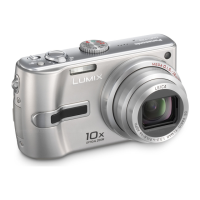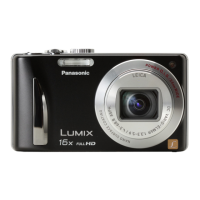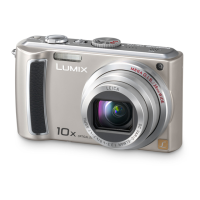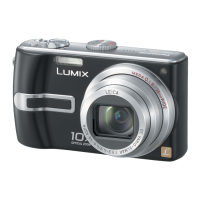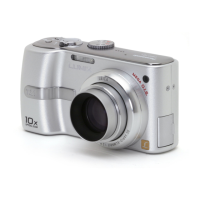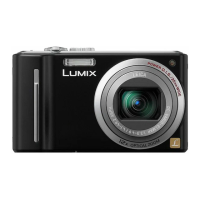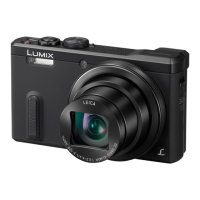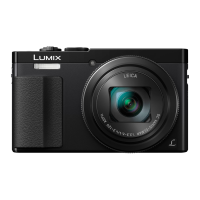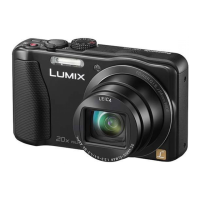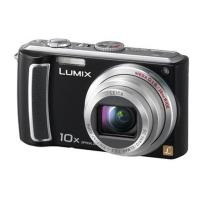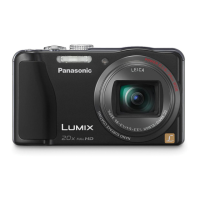140 VQT3H08 VQT3H08 141
Q&A Troubleshooting (Continued) Usage cautions and notes
Others
Menu not displayed in desired language.
●
Change [Language] setting (→49).
Camera rattles if shaken.
●
This sound is made by the lens movement and is not a fault.
Red lamp illuminated when pressing shutter button halfway in dark locations.
●
[AF Assist Lamp] is set to [ON] (→93).
AF Assist Lamp is not illuminated.
●
[AF Assist Lamp] is set to [OFF].
Camera is hot.
●
Camera may become a little warm during use, but this does not affect performance or quality.
Lens makes a clicking noise.
●
When brightness changes, the lens may make a clicking noise and the monitor brightness may also
change, but this is due to aperture settings being made.
(Does not affect recording.)
Clock is incorrect.
●
Camera has been left for a long period.
→ Reset the clock (→19).
●
Long time was taken to set clock (clock will be behind by the same lapse of time).
When using zoom, picture becomes slightly warped and the edges of the subject
become coloured.
●
Pictures may be slightly warped or coloured around the edges, depending on the zoom ratio, but
this is not a fault.
Zoom movement stops momentarily.
●
The zoom movement stops momentarily during Extra Optical Zoom and i.Zoom operation, but this is
not a malfunction.
Zoom does not reach the maximum ratio.
●
If the zoom ratio stops at 3 ×, [Macro Zoom] has been set. (→54)
File numbers are not recorded in sequence.
●
File numbers are reset when new folders are created (→125).
File numbers have jumped backwards.
●
Battery was removed/inserted with power on.
(Numbers may jump backwards if folder/file numbers are not correctly recorded.)
When no operation is performed for a while, the demo is suddenly displayed.
●
This is the Automatic Demo Mode that introduces the features of this camera.
Press [MENU/SET] to return to the previous screen.
When in use
●
Camera may become warm if used for long periods of time, but this is not a fault.
●
Keep the camera as far away as possible from electromagnetic equipment (such as
microwave ovens, TVs, video games etc.).
• If you use the camera on top of or near a TV, the pictures and sound on the camera may be
disrupted by electromagnetic wave radiation.
• Do not use the camera near cell phones because doing so may result in noise adversely affecting
the pictures and sound.
• Recorded data may be damaged, or pictures may be distorted, by strong magnetic fields created
by speakers or large motors.
• Electromagnetic wave radiation generated by microprocessors may adversely affect the camera,
disturbing the pictures and sound.
• If the camera is adversely affected by electromagnetic equipment and stops functioning properly,
turn the camera off and remove the battery or disconnect AC adaptor (optional). Then reinsert the
battery or reconnect AC adaptor and turn the camera on.
Do not use the camera near radio transmitters or high-voltage lines.
• If you record near radio transmitters or high-voltage lines, the recorded pictures and sound may
be adversely affected.
●
Do not extend the supplied cord or cable.
●
Do not allow camera to come into contact with pesticides or volatile substances (can cause surface
damage or coating to peel).
●
Never leave the camera and the battery in a car or on a car hood in the summer.
It may cause leakage of the battery electrolyte, a generation of heat, and may cause a fire and the
battery to burst due to the high temperature.
Caring for your camera
To clean your camera, remove the battery or disconnect the power plug from the outlet, and wipe with
a soft, dry cloth.
●
Use a damp cloth to remove stubborn stains, before wiping with a dry cloth.
●
Do not use benzene, thinners, alcohol, or kitchen detergent, as these may damage the outer casing
and finish of the camera.
●
If using a chemically-treated cloth, read the supplied instructions carefully.
●
Do not touch the lens barrier.
When not using for a while
●
Turn off camera power before removing battery and card (ensure that battery is removed to prevent
damage through over-discharge).
●
Do not leave in contact with rubber or plastic bags.
●
Store together with a drying agent (silica gel) if leaving in drawer, etc. Store batteries in cool (15 °C -
25 °C) places with low humidity (40 %RH - 60 %RH) and no major temperature changes.
●
Charge battery once per year and use completely before storing again.
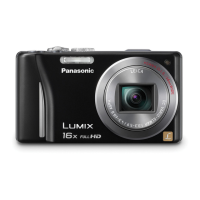
